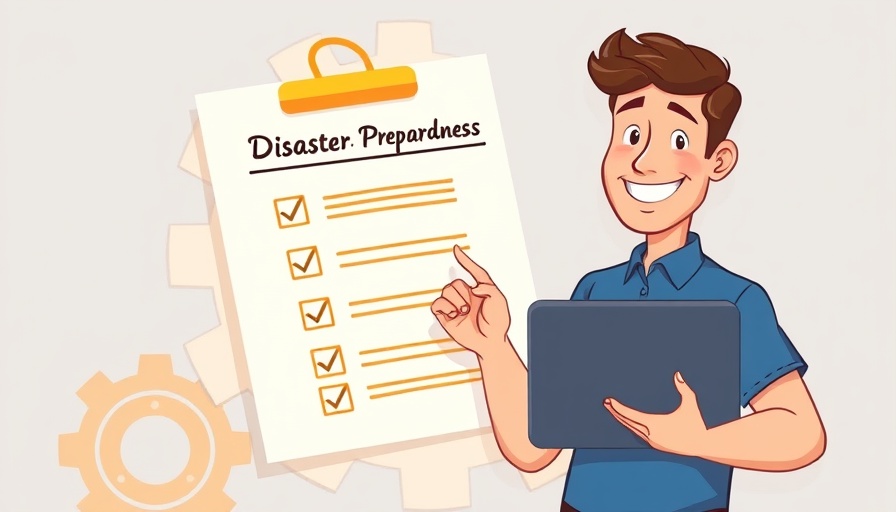
Understanding the Importance of Disaster Preparedness
As a small business owner or entrepreneur, your operational success can heavily depend on your ability to navigate unforeseen catastrophes. Hurricanes, wildfires, floods, and other natural disasters don’t just impact personal safety – they pose significant risks to your organization, affecting everything from revenue flow to employee welfare. In the wake of recent disasters, such as the wildfires that ravaged Los Angeles in January 2025, it’s become abundantly clear that preparation is key to resilience. In Florida, as hurricane season looms, the urgency to create a robust disaster preparedness plan intensifies.
Recognizing Your Vulnerabilities
Every business is uniquely susceptible to different types of disasters depending on its geographical location. For instance, businesses in Florida must remain vigilant of hurricanes, particularly from August to October, while those in California could face wildfires. Understanding your risks is the first step in preparing for what might come your way.
Engage in a threat assessment by evaluating previous disasters affecting your area and the challenges they presented. Knowing what could potentially disrupt your operations is not only vital for prioritizing safety but will also guide your disaster recovery planning, facilitating a quicker and more efficient recovery process. Assessing these risks now allows you to plan preventive measures today.
Crafting a Comprehensive Disaster Preparedness Plan
Benjamin Disraeli once said, “Prepare for the worst, but hope for the best.” Your disaster preparedness plan should cover key strategies and steps to ensure the safety of your employees, protection of your assets, and continuity of operations. This involves developing clear procedures for communication and actions before, during, and after a disaster.
Consider including the following elements in your plan:
- Safety protocols for employees: Ensure all staff members are aware of evacuation routes and safety measures in case of an emergency.
- Asset protection: Determine how to protect your equipment, inventory, and facilities during a disaster.
- Data security: Develop contingencies for protecting critical business data, such as tax information and customer records.
- Maintaining supply chains: Understand potential risks that could disrupt your supply chain and establish backup suppliers.
A comprehensive template for disaster recovery can provide a useful starting point for your plan. Resources like Ready.gov offer customizable templates tailored to your specific business needs.
Leveraging Technology and AI for Improved Planning
Utilizing technology, including advanced AI tools, can significantly streamline the creation and maintenance of an effective disaster recovery plan. For example, ChatGPT can help small business owners generate tailored plans quickly by providing guided prompts based on the unique characteristics of your business. This not only saves time but also ensures all critical points are systematically addressed.
Assessing Insurance Coverage
A robust disaster preparedness plan isn’t complete without a thorough evaluation of your current insurance coverage. Many entrepreneurs may assume their insurance encompasses all potential disasters; however, this is not always the case. Consult with an insurance agent to review your policy and identify any gaps that could leave your business vulnerable, especially when it comes to natural disasters like floods or earthquakes.
If necessary, consider enhancing your coverage with options such as flood insurance, business interruption insurance, or property insurance that is aligned with local risks. Understanding these options allows entrepreneurs to make informed decisions that can safeguard their financial stability in emergencies.
Establishing Reliable Contacts
Having up-to-date contact information is vital during a crisis. Your communication plan should include contact details for essential connections:
- Your employees: Designate a person responsible for reaching out to staff with emergency instructions.
- Your insurance agents: Include both your agent’s contact and the insurance company’s direct number in case your agent experiences the same disaster.
- Emergency services and FEMA: Understanding the quickest ways to reach for help can save critical time in emergencies.
By maintaining these connections, you’ll be better equipped to respond quickly to any disasters that may arise.
Building a Culture of Preparedness
Having a disaster preparedness plan is vital, but ensuring every employee understands the plan and feels safe is equally important. By fostering a culture of preparedness, businesses can cultivate a confident workforce that knows its role during a crisis. Regular training and drills can enhance preparedness, making staff more comfortable to respond effectively should a real disaster occur.
This proactive approach not only protects the business’s bottom line but contributes to employee morale and retention, showcasing a commitment to their safety and well-being.
A Call to Action
Overall, being prepared for disasters requires foresight, a well-structured plan, and effective communication. As we approach high-risk seasons for various disasters, take the crucial steps now to safeguard your business’s future. From establishing comprehensive plans to evaluating insurance needs, ensure you’re prepared to protect your greatest asset—your business. Don’t wait for disaster to strike, equip yourself with knowledge and resources today.
 Add Row
Add Row  Add
Add 




 Add Row
Add Row  Add
Add 

Write A Comment